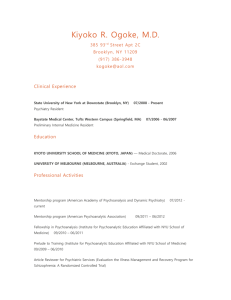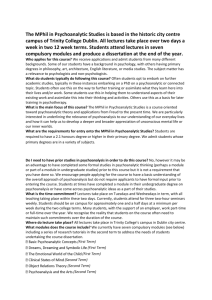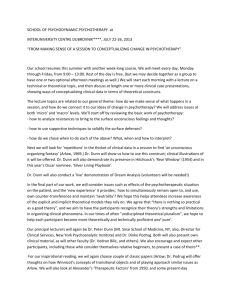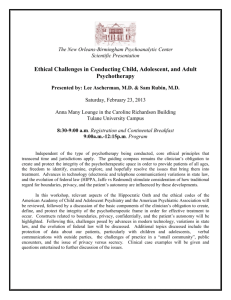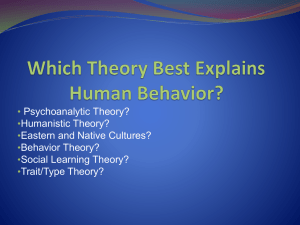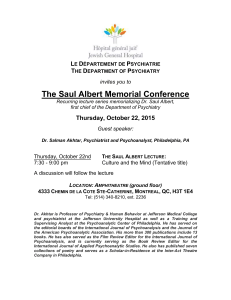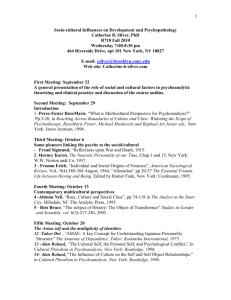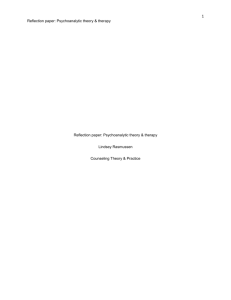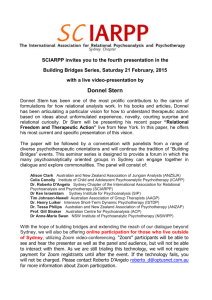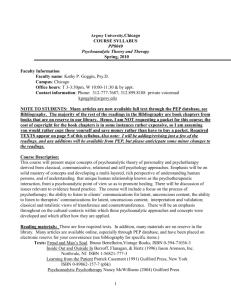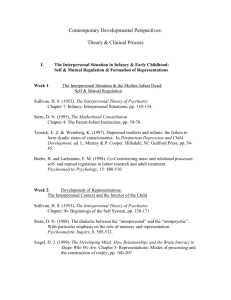2013-14 informal speaker series september - may
advertisement
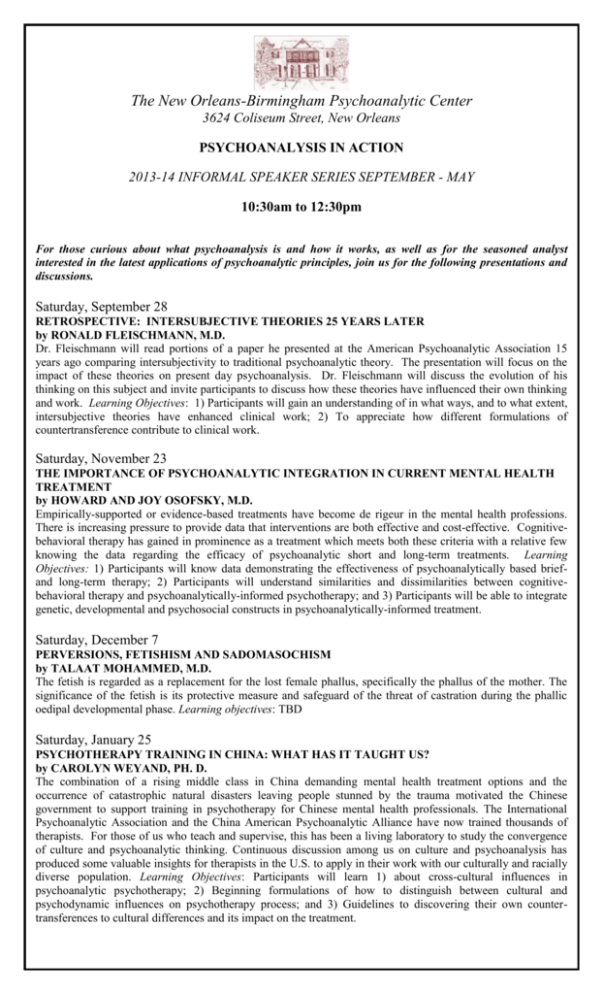
The New Orleans-Birmingham Psychoanalytic Center 3624 Coliseum Street, New Orleans PSYCHOANALYSIS IN ACTION 2013-14 INFORMAL SPEAKER SERIES SEPTEMBER - MAY 10:30am to 12:30pm For those curious about what psychoanalysis is and how it works, as well as for the seasoned analyst interested in the latest applications of psychoanalytic principles, join us for the following presentations and discussions. Saturday, September 28 RETROSPECTIVE: INTERSUBJECTIVE THEORIES 25 YEARS LATER by RONALD FLEISCHMANN, M.D. Dr. Fleischmann will read portions of a paper he presented at the American Psychoanalytic Association 15 years ago comparing intersubjectivity to traditional psychoanalytic theory. The presentation will focus on the impact of these theories on present day psychoanalysis. Dr. Fleischmann will discuss the evolution of his thinking on this subject and invite participants to discuss how these theories have influenced their own thinking and work. Learning Objectives: 1) Participants will gain an understanding of in what ways, and to what extent, intersubjective theories have enhanced clinical work; 2) To appreciate how different formulations of countertransference contribute to clinical work. Saturday, November 23 THE IMPORTANCE OF PSYCHOANALYTIC INTEGRATION IN CURRENT MENTAL HEALTH TREATMENT by HOWARD AND JOY OSOFSKY, M.D. Empirically-supported or evidence-based treatments have become de rigeur in the mental health professions. There is increasing pressure to provide data that interventions are both effective and cost-effective. Cognitivebehavioral therapy has gained in prominence as a treatment which meets both these criteria with a relative few knowing the data regarding the efficacy of psychoanalytic short and long-term treatments. Learning Objectives: 1) Participants will know data demonstrating the effectiveness of psychoanalytically based briefand long-term therapy; 2) Participants will understand similarities and dissimilarities between cognitivebehavioral therapy and psychoanalytically-informed psychotherapy; and 3) Participants will be able to integrate genetic, developmental and psychosocial constructs in psychoanalytically-informed treatment. Saturday, December 7 PERVERSIONS, FETISHISM AND SADOMASOCHISM by TALAAT MOHAMMED, M.D. The fetish is regarded as a replacement for the lost female phallus, specifically the phallus of the mother. The significance of the fetish is its protective measure and safeguard of the threat of castration during the phallic oedipal developmental phase. Learning objectives: TBD Saturday, January 25 PSYCHOTHERAPY TRAINING IN CHINA: WHAT HAS IT TAUGHT US? by CAROLYN WEYAND, PH. D. The combination of a rising middle class in China demanding mental health treatment options and the occurrence of catastrophic natural disasters leaving people stunned by the trauma motivated the Chinese government to support training in psychotherapy for Chinese mental health professionals. The International Psychoanalytic Association and the China American Psychoanalytic Alliance have now trained thousands of therapists. For those of us who teach and supervise, this has been a living laboratory to study the convergence of culture and psychoanalytic thinking. Continuous discussion among us on culture and psychoanalysis has produced some valuable insights for therapists in the U.S. to apply in their work with our culturally and racially diverse population. Learning Objectives: Participants will learn 1) about cross-cultural influences in psychoanalytic psychotherapy; 2) Beginning formulations of how to distinguish between cultural and psychodynamic influences on psychotherapy process; and 3) Guidelines to discovering their own countertransferences to cultural differences and its impact on the treatment. The New Orleans-Birmingham Psychoanalytic Center 3624 Coliseum Street, New Orleans Saturday, March 22 DEPRIVATION AND DELINQUENCY: D.W. WINNICOTT’S OBSERVATIONS ON THE ROOTS OF AGGRESSION by PAUL HUFNAGEL, LCSW, PH.D. For a city rife with juvenile crime and daily acts of violence, D.W. Winnicott’s collection of work in Deprivation and Delinquency can provide invaluable insight and needed commentary into the early emotional and psychological origins of delinquency, aggression and anti-social behavior. This presentation will review Winnicott’s early work at the Paddington Green Children’s Hospital in London with evacuated and orphaned children during the Second World War, highlighting both diagnostic and clinical observations from this traumatic wartime experience. Supplementing and reinforcing Winnicott’s important observations on the roots of violence and aggression, scenes from Francois Truffaut’s classic 1959 film-- 400 Blows will be used to illustrate how the lack of “good enough mothering” and neglect influence the developing mind and inevitable behavior of the child. Learning Objectives: 1) Assist participants to think more critically—both psychoanalytically and systemically-- about issues of juvenile violence and aggression—issues which increasingly impact and traumatize our society; and 2) Deepen and broaden our understanding—not only as clinicians but as citizens of the wider community-- around the critical concepts of “the holding environment” and “good enough mothering.” Saturday, April 5 PROJECT FOR A SCIENTIFIC PSYCHOLOGY-REVISITED by JEFFREY NICHOLL, M.D. The founder of psychoanalysis, Sigmund Freud, was a neurologist by training and considered himself a scientist-practitioner. In correspondence with Fleiss, he developed a model of neurological functioning which would explain the phenomena he had identified through psychoanalytic exploration. His work was hailed as bringing a rapprochement between psychoanalysis and neurophysiology, but his success was limited. The objective of this presentation will be to educate participants about Freud's conception of the unconscious in light of current findings in neuroscience. Participants will have a greater understanding of some of the neurological underpinnings of Freud’s topographical model. Saturday, May 10 IS THERE BALM IN GILEAD? by AL BURSTEIN, PH. D. Dr. Burstein will review two recent books relevant to the status of Psychoanalysis as a profession: The Death of the Guilds by Elliot Krause and Psychoanalysis at the Margins by Paul Stepansky. Taken together, they paint a grim picture of the future. After reviewing the books, Dr. Burstein will offer his views of a constructive response to the challenges described, and will encourage further discussion. Learning objective: Participants will become better acquainted with some challenges facing Psychoanalysis as a profession, and thus be better prepared to deal with them constructively. This activity has been planned and implemented in accordance with the Essential Areas and policies of the Accreditation Council for Continuing Medical Education through the joint sponsorship of the American Psychoanalytic Association and the New Orleans Birmingham Psychoanalytic Center. The American Psychoanalytic Association is accredited by the ACCME to provide continuing medical education for physicians. The American Psychoanalytic Association designates this Live Activity for a maximum of 2.0 hrs/ session AMA PRA Category 1 Credit(s) ™. Physicians should claim only the credit commensurate with the extent of their participation in the activity. IMPORTANT DISCLOSURE INFORMATION FOR ALL LEARNERS: None of the planners and presenters of this CME program have any relevant financial relationships to disclose. Psychologists and Social Workers may also receive continuing education credit for this activity if their accredited associations or boards recognize CME credits.
